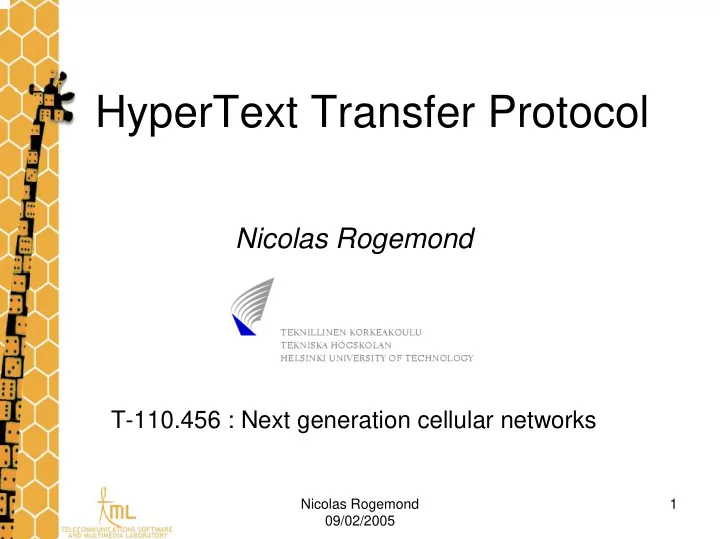

HyperText Transfer Protocol Nicolas Rogemond T-110.456 : Next generation cellular networks Nicolas Rogemond 1 09/02/2005
Introduction Definition • HTTP is defined in RFC 2068 as “an ubiquitous application level protocol for distributed, collaborative, hypermedia information systems” • HTTP is a stateless object-oriented protocol (i.e. does not require the client and the server to keep track and state of messages exchanged) Nicolas Rogemond 2 09/02/2005
Introduction History HTTP was first proposed by Tim Berners-Lee at CERN in order to help researchers navigate through the number of research papers and project at the laboratory. January 1992 HTTP/0.9 March 1993 HTTP/1.0 first Draft November 1993 HTTP/1.0 second Draft March 1996 HTTP/1.0 informational, RFC 1945 January 1997 HTTP/1.1 proposed standard, RFC 2068 June 1999 HTTP/1.1 draft standard, RFC 2616 June 2001 HTTP/1.1 formal standard RFC 2068 Nicolas Rogemond 3 09/02/2005
Improvements The main goals of the HTTP/1.1 is to remove any inconsistency and resolve the inter-operability issues that exploded with the previous version of the HTTP • Consistent request and response methods • Persistent connections • Digest authentication • Chunked encoding • New headers • Content negotiation • Byte range operation Nicolas Rogemond 4 09/02/2005
Improvements Consistent request and response methods In addition to the GET, HEAD and POST methods of HTTP/1.0, HTTP/1.1 defined and finalized the semantics of 5 new methods request types : » DELETE » PUT » OPTIONS » TRACE » CONNECT Nicolas Rogemond 5 09/02/2005
Improvements Persistent connections • Persistent connection as default behaviour • Pipelining Nicolas Rogemond 6 09/02/2005
Improvements Chunked encoding • In HTTP, it is very important to indicate the length of the response message being sent to be sure that no loss occurs during the transfer • HTTP/1.0 indicates the length of the message by closing the connection after transmitting the full message • HTTP/1.1 uses a “Content-length” field in the header and if needed (e.g. dynamic generated answers) the Chunked encoding Nicolas Rogemond 7 09/02/2005
Improvements Content negotiation HTTP/1.1 defines 2 types of content negotiation : • Server driven (based on client’s request) : the server will choose the appropriate format and representation of the resource according to the request headers and/or the client IP • Agent driven : this occurs when the server provides the user agent alternatives to the available resource. It is up to the user agent to indicate the best representation Nicolas Rogemond 8 09/02/2005
Improvements Digest authentication • The digest authentication is an other security layer in addition to the “basic authentication” one • The principle is the same (based on username and password) but in this one, the “keys” are encrypted. Nicolas Rogemond 9 09/02/2005
Improvements Headers • HTTP headers are metadata that describe the resource being sent. They play a major role in HTTP specification and implementation in that way they extend the capabilities of the protocol • HTTP/1.1 classified 4 types of headers : • General headers End to End headers • Entity headers • Request headers Hop by Hop headers • Response headers Nicolas Rogemond 10 09/02/2005
Improvements Byte range operation Byte range operation allows client to download a range of bytes instead of the entire document, the consequences are : – Recovery from failed transfers – Multiple transfers of the same document as the same time – Work with small parts of large documents without completely downloading them Nicolas Rogemond 11 09/02/2005
Competing Technology : MHSP • MHSP (Multiple Hypertext Stream Protocol) • MHSP is a full-duplex, symmetric protocol that the proxy uses to communicate with wireless clients. It is designed to reduce latency while allowing the client to take advantage of available bandwidth Nicolas Rogemond 12 09/02/2005
Competing Technology : MHSP MHSP has the following features : – maintains a permanent connection – transfers more than one file simultaneously – allows both clients and proxy to initiate and stop file transfers – tracks the progress of file transfers, allowing stopped transfers to be resumed – maintains compatibility with existing networks by running on top of TCP Nicolas Rogemond 13 09/02/2005
Application for mobile telecommunications • All WML (Wireless Mark-up Language) content is accessed over the Internet using standard HTTP/1.1 requests • WAP 2.0 Nicolas Rogemond 14 09/02/2005
What’s next? HTTP/NG (New Generation) • The World Wide Web Consortium (W3C) and Internet Engineering Task Force (IETF) are actively working with the WAP Forum to evolve HTTP-NG to better meet the requirements of future wireless network technologies (3G wireless network) • HTTP-NG is a comprehensive rethinking of the Web’s underlying protocol. It provides a framework for defining new Web applications, a powerful messaging system, and a multiplexing transport layer Nicolas Rogemond 15 09/02/2005
HTTP/NG • 3 layer architecture : – Transport Layer – Messaging Layer – Application Layer Performances comparisons Realized with W3C Microscape benchmark HTTP/NG 0.19sec HTTP/1.1 Pipelined 0.23sec CORBA’s IIOP 1.0 0.58sec Nicolas Rogemond 16 09/02/2005
Conclusion • HTTP/1.1 has been developed to facilitate the convergence between mobile communication (2G/3G) and the fixed networks • HTTP & HTML were the basis of the web’s rapid growth in the early 90’s, HTTP/1.1 can be the basis of the growth of mobile communication Nicolas Rogemond 17 09/02/2005
End of the lecture Thanks for your attention Nicolas Rogemond 18 09/02/2005
Recommend
More recommend